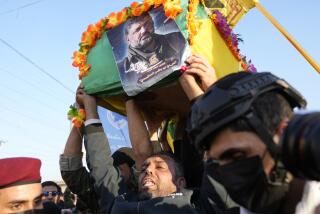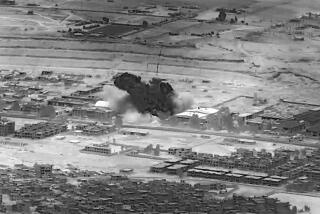QUICK KNOCKOUT OR STREET FIGHT?
- Share via
WASHINGTON — U.S. forces are poised to begin the battle for Baghdad by pounding Republican Guard troops on the southern perimeter of the Iraqi capital, hoping that with a crushing blow they can demoralize the remaining forces and avoid a bloody urban battle of attrition.
After a week of breakneck advance and skirmishing, about 75,000 U.S. troops are confronting about 35,000 Iraq soldiers arrayed in three Republican Guard divisions south of the city.
Yet tough terrain, new Iraqi tactics, restrictive American rules of combat and limited U.S. forces could make the fight longer and bloodier than U.S. commanders expected.
“It’s going to be tough work, dangerous work -- we’re going to take casualties,” warned retired Army Gen. Barry McCaffrey, who commanded a division in the 1991 Persian Gulf War.
President Bush could face a momentous military and political decision: whether to move now and maintain momentum but risk heavy casualties, or await the arrival of the 4th Infantry Division, which could be weeks away.
Unless U.S. commanders decide to wait for reinforcements, the airstrikes already launched against the dug-in Iraqis could soon be supplemented with an artillery and rocket bombardment. Then, hundreds of U.S. tanks would open a full-scale ground assault, with the goal of destroying most of the Republican Guard’s equipment before it could be withdrawn into the city, experts predict.
U.S. leaders are eager to avoid a fight in Baghdad for fear that it would cause huge casualties among troops and civilians, and widespread destruction.
The Republican Guard units are within 50 miles or so of Baghdad. They include the Medina Division north of Karbala and the Baghdad Division toward Al Kut. A few miles behind them, in a supporting role, is a third division.
Arrayed against the Iraqis are the U.S. 3rd Infantry Division, south of Karbala, and the 1st Marine Expeditionary Force, moving into position to the east, south of Al Kut. Other U.S. units, including troops of the 101st Airborne Division and a Marine brigade, bring the total force near Baghdad to about 75,000 troops, said Daniel Goure, a former Pentagon official now with the Lexington Institute research firm in Virginia.
U.S. forces in the war theater total about 250,000, and are growing by about 2,000 a day, according to Defense Secretary Donald H. Rumsfeld.
This week, the Republican Guard divisions were designated the top target of U.S. air attacks, displacing Iraqi leadership facilities in Baghdad. “We are shifting from one phase of an operation to another,” Col. Gary Crowder, a senior planner with U.S. Air Combat Command, said in an interview.
In addition to the Medina Division, Air Force and Navy strike aircraft are attacking the Hammurabi Division, one of two Republican Guard units north of the city, officials said.
This suggests that the United States might drop paratroopers from the 101st Airborne Division into the north side of the city to begin an assault and close off access routes. The 101st Airborne alone has 72 Apache attack helicopters that could destroy large numbers of tanks and armored vehicles as the main body of the U.S. ground force was sweeping toward the city from the south, military strategists said.
Some U.S. officers in the field said they were eager to begin the attack. “We’re going to take the full fight to him,” Col. Ben Saylor, chief of staff for the 1st Marine Division, said in an interview. He said his division will take the middle part of the battlefield when U.S. ground forces begin their assault, with the 3rd Infantry to the west and other Marine units to the east.
The timing of the attack remained uncertain. Some Pentagon officials said U.S. forces may pause to let the air attack “soften up” Iraqi field forces, while U.S. ground forces resupply and consolidate at the front lines. “We’ve already taken a lot of ground, and we’ve done a lot of things with fewer forces than have been used before,” one Pentagon official said. “I’d say it’s a good time to breathe, rearm, refuel.”
Some officials have also suggested that U.S. forces might want to take time to conduct reconnaissance on the Republican Guard units, which have been maneuvering rapidly in recent days as a sandstorm obscured their movements.
And it may take some time for warplanes to take out the Republican Guard forces, which are well-concealed.
In the 1991 war, allied air forces crushed Iraqi field equipment that had nowhere to hide in the featureless desert of southern Iraq and Kuwait.
This time, the Republican Guard has hidden tanks, armored personnel carriers and other equipment under trees and near mosques, schools and hospitals to protect them from U.S. forces that are reluctant to risk civilian casualties and infrastructure, military officials say.
The tactics suggest that Saddam Hussein has learned from the Kosovo war of 1999, in which Serbian leader Slobodan Milosevic proved that the Pentagon’s precision bombing had a limited capacity to take out military equipment concealed in Balkan forests and villages.
Hussein’s military “clearly went to school on Kosovo,” said a senior defense official. “They’re clearly a learning adversary.”
Kenneth M. Pollack, a former CIA analyst and Iraq specialist, said the tough terrain of central Iraq has become one of Hussein’s greatest advantages. It is rolling country, with more trees and vegetation than most of the desert nation. “The terrain is the critical difference out there,” Pollack, who is director of research at the Brookings Institution’s Saban Center, said at a conference Thursday.
Apache helicopters usually fire missiles at tanks and other large equipment from two or three kilometers, he said. But in recent days, to locate targets in the rough terrain, they have had to fly closer to the ground, exposing them to dangerous antiaircraft and small-arms fire from the Iraqi troops.
Earlier this week, an attack by 32 Apaches ended with two downed helicopters, battle damage to many others and Iraqi losses of only a handful of vehicles.
But some military experts said the Apaches would not be so vulnerable when the full battle begins, and fire from artillery, rockets and tanks reduces the threat from ground troops.
Pollack said that because the Republican Guard was forced to retreat into Iraq during the first gulf war, many Americans have the impression that they are poor fighters.
In fact, he said, they were “like tigers” against the Army’s VII Corps in 1991, and should be expected to fiercely resist the coming assault.
U.S. officials say they intend to continue to observe their own combat restrictions that bar troops from endangering civilians and important infrastructure. The Euphrates and Tigris valleys, where troops are now concentrated, are areas with light industry, some heavily populated areas and religious and archeological sites.
Some experts believe, however, that finishing off the Republican Guard is such a high priority that U.S. officials will decide to ease up on the rules.
“I would be surprised if we don’t take the gloves off to some degree,” said analyst Goure.
After the guard divisions are battered with aircraft strikes, the U.S. forces will move artillery and multiple rocket launchers closer to Iraqi lines to accelerate the destruction. The tank attack will begin once it appears that about 50% of the enemy positions are destroyed, Goure said.
As the Iraqis fall to the attack, U.S. officials say, they could still bring a last capability into play: chemical and germ weapons.
U.S. officials believe Hussein has been hoping to win a negotiated peace through international pressure or U.S. fear of casualties, without using his suspected arsenal of unconventional weapons. But officials still believe the risk, especially from chemical weapons, will mount as the divisions are destroyed.
While the American forces have formidable firepower, they have far less than Army doctrine usually requires. Some former Army commanders, such as McCaffrey and former Gen. Wesley Clark, who was Supreme Allied Commander for Europe, have publicly faulted the administration for not having enough heavy divisions as a hedge against unforeseen problems.
Some former planners say that while there is no question the American side will defeat the Republican Guard, less force may mean a longer fight and more casualties.
Retired Col. Samuel Gardiner, a former Air Force planner, said the high-profile criticism makes the administration politically vulnerable. “You don’t send American men and women into battle without all it takes,” he said in an interview on PBS. “If we go to Baghdad with two divisions and there are high losses, that’s regime change kind of stuff. And I don’t mean Baghdad regime change.”
*
Times staff writers Peter Pae in Los Angeles and Esther Schrader in Washington contributed to this report.
More to Read
Sign up for Essential California
The most important California stories and recommendations in your inbox every morning.
You may occasionally receive promotional content from the Los Angeles Times.














